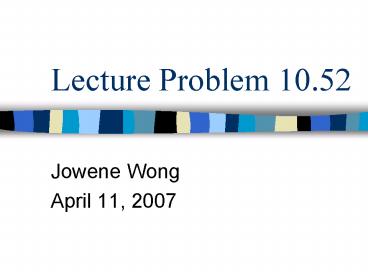Lecture Problem 10'52 PowerPoint PPT Presentation
1 / 18
Title: Lecture Problem 10'52
1
Lecture Problem 10.52
- Jowene Wong
- April 11, 2007
2
Problem Statement
- Consider 1.0 kg of austenite containing 1.15 wt
C, cooled to below 727oC (1341oF). - What is the proeutectoid phase?
- How many kilograms each of total ferrite and
cementite form? - How many kilograms each of pearlite and the
proeuctectoid phase form? - Schematically sketch and label the resulting
microstructure.
3
Background
- Microstructures structural features of an alloy
(e.g. grain and phase structure) that are subject
to observation under a microscope - Big picture
- Develop due to carbon content and heat treatment
(slow heating in this case) - Metals phases present, proportions, and
arrangement - Affect mechanical properties
4
Background
- Microconstituent element of the microstructure
that has an identifiable and characteristic
structure, may consist of more than one phase
(i.e. pearlite) - Stuff you see under the microscope
- Depends on thermal history
- Phase homogeneous portion of a system (material
under consideration) that has uniform physical
and chemical characteristics - Solid, liquid, gas
- Stuff you see in the phase diagram
- For any slow-cooling thermal history that begins
in a 1-phase region, microconstituents are the
same as phases unless you cross a 3-phase
invariant
5
Background
- Eutectic (phase/reaction/structure) when a
liquid transforms isothermally and reversibly
into two intimately mixed solid phases by cooling - Eutectoid (reaction) when a solid phase
transforms isothermally and reversibly into two
new intimately mixed solid phases - Proeutectoid forms before eutectoid
6
Background Phase Diagram
invariant point
eutectic isotherm (three-phase invariant)
invariant point
eutectoid isotherm (three-phase invariant)
7
Background
- Carbon is an interstitial impurity in iron
- Diffused into iron
- Austenite ? iron, 912oC, FCC
- Ferrite a iron, room temp, BCC
- Soft and ductile
- Cementite Fe3C
- Hard and brittle
austenite
ferrite
8
Background
- Upon cooling into ? Fe3C phase, cementite
starts to form along grain boundaries - Tie line (phase compositions found using
endpoints) - Composition of austenite moves along PO boundary
- Composition of cementite stays same (6.7 wt C)
- Austenite ? pearlite
- Proeutectoid cementite
9
Background
- Pearlite two-phase microstructure, when
austenite of eutectoid composition transforms,
consists of alternating layers of ferrite and
cementite - Exists as grains (colonies)
- Layers in same orientation in each colony
- Light ferrite, dark cementite
- Layers form because parent phase (austenite)
different from product phases (ferrite,
cementite) and carbon needs to be redistributed
by diffusion
10
Background
- Hypoeutectoid alloy iron-carbon alloy between
0.022 and 0.76 wt C - Hypereutectoid alloy iron-carbon alloy between
0.76 and 2.14 wt C
11
Solution (a)
- This is a hypereutectoid alloy, so the
proeutectoid phase is - proeutectoid cementite
12
Solution (b)
- Lever rule, tie line
Ca
CFe3C
Co
13
Solution (b)
- Find the phase compositions.
14
Solution (b)
- Lever rule, tie line
Cp
CFe3C
Co
15
Solution (c)
- Find the microconstituent compositions.
16
Solution (d)
- Figure 10.35 1.4 wt C steel
- Actual schematic has proeutectoid cementite
because its 1.15 wt C
pearlite
proeutectoid cementite
ferrite
cementite
17
Applications
- Form a material with the desired properties
- Steels and cast irons are the primary structural
materials - 1.15 wt C steel mainly used for cutting tools
- Can physically check you obtained the desired
composition
18
Questions?!

